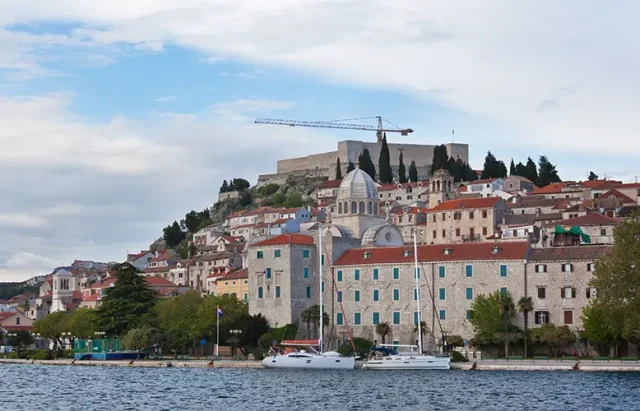
Šibenik stands at the point where the Krka River meets the Adriatic Sea. From a distance, it appears like a sculpture carved from pale stone, its houses rising in layers up the hill toward the fortress. The water below reflects the same muted color, so that the town seems to emerge directly from the landscape.
Unlike many cities on the Dalmatian coast, Šibenik was founded by Croatians, not by Greeks or Romans. That gives it a different rhythm, more inward, more patient. Its beauty lies not in grandeur but in intricacy. The entire old town feels like a labyrinth built by hand, every street a thread of limestone.
The Weight of Stone
To walk in Šibenik is to feel the presence of stone underfoot, overhead, and all around. The streets are narrow and uneven, worn smooth by centuries of footsteps. Walls lean into one another, creating tunnels of shadow that open suddenly into bright courtyards.
The most famous building is the Cathedral of St. James, a masterpiece of the fifteenth century and one of the most remarkable structures on the Adriatic. Built entirely of stone, without mortar, it stands like a living organism — every block fitted with care, every detail carved with precision.
The cathedral’s frieze of seventy-one sculpted faces, each unique, watches quietly over the square. Some smile faintly, others frown, all of them frozen mid-thought. They seem to embody the spirit of Šibenik itself: human, enduring, and quietly expressive.
Inside, light moves slowly across the white walls, softening the edges of the stone. The stillness feels absolute, yet never cold.
A City Built on Layers
Šibenik’s old town is built vertically, one terrace above another. From the harbor, stairways climb past arches, balconies, and shuttered windows. The sound of the sea fades as you rise, replaced by the echo of footsteps and the occasional voice calling from a doorway.
Every level of the city tells a different story. Near the water, fishermen mend nets beside moored boats. Higher up, artisans work in small shops tucked between stairways. At the top stands the fortress of St. Michael, once a lookout against invaders, now a place for music and open-air concerts.
From there, the view stretches across the bay and the islands beyond. In the evening, the sea turns silver and the roofs glow amber in the fading light. The wind carries the smell of salt and rosemary.
Between River and Sea
Šibenik’s identity is shaped by water as much as by stone. The Krka River flows from the inland mountains through a series of waterfalls before meeting the sea here. Its estuary forms a long, sheltered inlet that has protected the town for centuries.
Upstream lies Krka National Park, a landscape of cascading water, green valleys, and old mills that still turn with the current. Wooden walkways wind through the park, crossing clear pools where fish swim in the shallows. The river moves slowly, its surface reflecting sky and forest.
It is possible to follow part of this journey by bicycle. Many Croatia bike tours now trace routes between the waterfalls of Krka and the coastal roads that lead to Šibenik. The terrain shifts between quiet countryside and sea views, passing through olive groves, vineyards, and stone villages that feel untouched by time.
Cycling here is not about speed but rhythm. Each climb offers another glimpse of the water, each descent brings the scent of pine and salt. The ride feels like an extension of the landscape itself — patient, luminous, and full of space to breathe.
The Light of the Afternoon
In the old town, the narrow streets are often half in shadow. The light enters only where the alleys widen or the walls fall back. Around midday, it seems to slide down the stone like water, turning the city into a play of brightness and coolness.
You find small squares where children play beside wells, or old men sit on benches talking softly. The rhythm of life here has little to do with time. Cafés stay half-full from morning to night, and the sound of conversation drifts through open windows.
The markets near the harbor are another world of light and sound. Tables overflow with figs, tomatoes, fish, and herbs. Sellers greet each customer by name. The sea breeze carries the smell of salt and fruit, and somewhere nearby, a church bell marks the hour.
The Fortresses Above
Šibenik is guarded by four fortresses, each watching from a different hill. St. Michael is the oldest, but others — Barone, St. John, and St. Nicholas — complete the circle. From their walls, the view takes in the islands, the river, and the long line of the coast.
St. Nicholas, built at the mouth of the bay, is the most dramatic. Its triangular form rises from the sea itself, a reminder of when fortifications were built to match the shape of the world around them. You can reach it by boat, crossing the water that once carried Venetian galleys and merchant ships.
The stone here has turned pale from centuries of sun and salt. Touching it feels like touching time itself.
Evening Returns
As the sun lowers, Šibenik changes again. The shadows lengthen, the air cools, and the stone begins to glow. The streets empty, then fill once more as people wander down toward the water. Restaurants open their doors, and the smell of grilled fish, olive oil, and lemon spreads through the alleys.
The sea reflects the lights from the harbor, and the sound of music rises softly from the cafés. Above it all, the cathedral stands calm and unmoving, its stone slowly losing the day’s warmth.
You sit by the edge of the quay, watching the reflection of the city ripple in the darkening water. The wind shifts, carrying a trace of salt, and you realize how quietly complete this place feels.
Šibenik is not a city that performs. It exists, patiently and precisely, like the stone from which it was made. The more you look, the more you begin to understand that its beauty lies not in what changes but in what endures.





